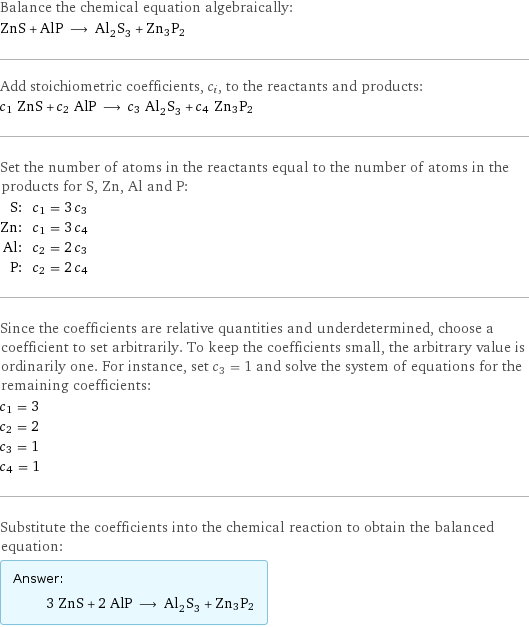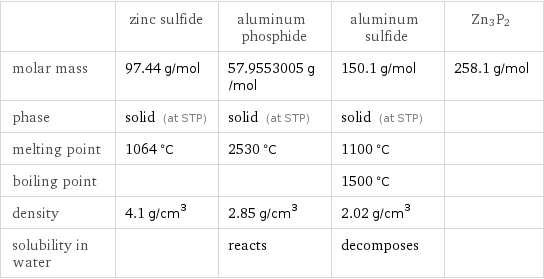Input interpretation

ZnS zinc sulfide + AlP aluminum phosphide ⟶ Al_2S_3 aluminum sulfide + Zn3P2
Balanced equation

Balance the chemical equation algebraically: ZnS + AlP ⟶ Al_2S_3 + Zn3P2 Add stoichiometric coefficients, c_i, to the reactants and products: c_1 ZnS + c_2 AlP ⟶ c_3 Al_2S_3 + c_4 Zn3P2 Set the number of atoms in the reactants equal to the number of atoms in the products for S, Zn, Al and P: S: | c_1 = 3 c_3 Zn: | c_1 = 3 c_4 Al: | c_2 = 2 c_3 P: | c_2 = 2 c_4 Since the coefficients are relative quantities and underdetermined, choose a coefficient to set arbitrarily. To keep the coefficients small, the arbitrary value is ordinarily one. For instance, set c_3 = 1 and solve the system of equations for the remaining coefficients: c_1 = 3 c_2 = 2 c_3 = 1 c_4 = 1 Substitute the coefficients into the chemical reaction to obtain the balanced equation: Answer: | | 3 ZnS + 2 AlP ⟶ Al_2S_3 + Zn3P2
Structures

+ ⟶ + Zn3P2
Names

zinc sulfide + aluminum phosphide ⟶ aluminum sulfide + Zn3P2
Equilibrium constant
![Construct the equilibrium constant, K, expression for: ZnS + AlP ⟶ Al_2S_3 + Zn3P2 Plan: • Balance the chemical equation. • Determine the stoichiometric numbers. • Assemble the activity expression for each chemical species. • Use the activity expressions to build the equilibrium constant expression. Write the balanced chemical equation: 3 ZnS + 2 AlP ⟶ Al_2S_3 + Zn3P2 Assign stoichiometric numbers, ν_i, using the stoichiometric coefficients, c_i, from the balanced chemical equation in the following manner: ν_i = -c_i for reactants and ν_i = c_i for products: chemical species | c_i | ν_i ZnS | 3 | -3 AlP | 2 | -2 Al_2S_3 | 1 | 1 Zn3P2 | 1 | 1 Assemble the activity expressions accounting for the state of matter and ν_i: chemical species | c_i | ν_i | activity expression ZnS | 3 | -3 | ([ZnS])^(-3) AlP | 2 | -2 | ([AlP])^(-2) Al_2S_3 | 1 | 1 | [Al2S3] Zn3P2 | 1 | 1 | [Zn3P2] The equilibrium constant symbol in the concentration basis is: K_c Mulitply the activity expressions to arrive at the K_c expression: Answer: | | K_c = ([ZnS])^(-3) ([AlP])^(-2) [Al2S3] [Zn3P2] = ([Al2S3] [Zn3P2])/(([ZnS])^3 ([AlP])^2)](../image_source/10315cf3447eb84d703613c0efaff143.png)
Construct the equilibrium constant, K, expression for: ZnS + AlP ⟶ Al_2S_3 + Zn3P2 Plan: • Balance the chemical equation. • Determine the stoichiometric numbers. • Assemble the activity expression for each chemical species. • Use the activity expressions to build the equilibrium constant expression. Write the balanced chemical equation: 3 ZnS + 2 AlP ⟶ Al_2S_3 + Zn3P2 Assign stoichiometric numbers, ν_i, using the stoichiometric coefficients, c_i, from the balanced chemical equation in the following manner: ν_i = -c_i for reactants and ν_i = c_i for products: chemical species | c_i | ν_i ZnS | 3 | -3 AlP | 2 | -2 Al_2S_3 | 1 | 1 Zn3P2 | 1 | 1 Assemble the activity expressions accounting for the state of matter and ν_i: chemical species | c_i | ν_i | activity expression ZnS | 3 | -3 | ([ZnS])^(-3) AlP | 2 | -2 | ([AlP])^(-2) Al_2S_3 | 1 | 1 | [Al2S3] Zn3P2 | 1 | 1 | [Zn3P2] The equilibrium constant symbol in the concentration basis is: K_c Mulitply the activity expressions to arrive at the K_c expression: Answer: | | K_c = ([ZnS])^(-3) ([AlP])^(-2) [Al2S3] [Zn3P2] = ([Al2S3] [Zn3P2])/(([ZnS])^3 ([AlP])^2)
Rate of reaction
![Construct the rate of reaction expression for: ZnS + AlP ⟶ Al_2S_3 + Zn3P2 Plan: • Balance the chemical equation. • Determine the stoichiometric numbers. • Assemble the rate term for each chemical species. • Write the rate of reaction expression. Write the balanced chemical equation: 3 ZnS + 2 AlP ⟶ Al_2S_3 + Zn3P2 Assign stoichiometric numbers, ν_i, using the stoichiometric coefficients, c_i, from the balanced chemical equation in the following manner: ν_i = -c_i for reactants and ν_i = c_i for products: chemical species | c_i | ν_i ZnS | 3 | -3 AlP | 2 | -2 Al_2S_3 | 1 | 1 Zn3P2 | 1 | 1 The rate term for each chemical species, B_i, is 1/ν_i(Δ[B_i])/(Δt) where [B_i] is the amount concentration and t is time: chemical species | c_i | ν_i | rate term ZnS | 3 | -3 | -1/3 (Δ[ZnS])/(Δt) AlP | 2 | -2 | -1/2 (Δ[AlP])/(Δt) Al_2S_3 | 1 | 1 | (Δ[Al2S3])/(Δt) Zn3P2 | 1 | 1 | (Δ[Zn3P2])/(Δt) (for infinitesimal rate of change, replace Δ with d) Set the rate terms equal to each other to arrive at the rate expression: Answer: | | rate = -1/3 (Δ[ZnS])/(Δt) = -1/2 (Δ[AlP])/(Δt) = (Δ[Al2S3])/(Δt) = (Δ[Zn3P2])/(Δt) (assuming constant volume and no accumulation of intermediates or side products)](../image_source/7a9081188d3f8154b7f0eccbea0d24c8.png)
Construct the rate of reaction expression for: ZnS + AlP ⟶ Al_2S_3 + Zn3P2 Plan: • Balance the chemical equation. • Determine the stoichiometric numbers. • Assemble the rate term for each chemical species. • Write the rate of reaction expression. Write the balanced chemical equation: 3 ZnS + 2 AlP ⟶ Al_2S_3 + Zn3P2 Assign stoichiometric numbers, ν_i, using the stoichiometric coefficients, c_i, from the balanced chemical equation in the following manner: ν_i = -c_i for reactants and ν_i = c_i for products: chemical species | c_i | ν_i ZnS | 3 | -3 AlP | 2 | -2 Al_2S_3 | 1 | 1 Zn3P2 | 1 | 1 The rate term for each chemical species, B_i, is 1/ν_i(Δ[B_i])/(Δt) where [B_i] is the amount concentration and t is time: chemical species | c_i | ν_i | rate term ZnS | 3 | -3 | -1/3 (Δ[ZnS])/(Δt) AlP | 2 | -2 | -1/2 (Δ[AlP])/(Δt) Al_2S_3 | 1 | 1 | (Δ[Al2S3])/(Δt) Zn3P2 | 1 | 1 | (Δ[Zn3P2])/(Δt) (for infinitesimal rate of change, replace Δ with d) Set the rate terms equal to each other to arrive at the rate expression: Answer: | | rate = -1/3 (Δ[ZnS])/(Δt) = -1/2 (Δ[AlP])/(Δt) = (Δ[Al2S3])/(Δt) = (Δ[Zn3P2])/(Δt) (assuming constant volume and no accumulation of intermediates or side products)
Chemical names and formulas

| zinc sulfide | aluminum phosphide | aluminum sulfide | Zn3P2 formula | ZnS | AlP | Al_2S_3 | Zn3P2 Hill formula | SZn | AlP | Al_2S_3 | P2Zn3 name | zinc sulfide | aluminum phosphide | aluminum sulfide | IUPAC name | thioxozinc | alumanylidynephosphane | thioxo-(thioxoalumanylthio)alumane |
Substance properties

| zinc sulfide | aluminum phosphide | aluminum sulfide | Zn3P2 molar mass | 97.44 g/mol | 57.9553005 g/mol | 150.1 g/mol | 258.1 g/mol phase | solid (at STP) | solid (at STP) | solid (at STP) | melting point | 1064 °C | 2530 °C | 1100 °C | boiling point | | | 1500 °C | density | 4.1 g/cm^3 | 2.85 g/cm^3 | 2.02 g/cm^3 | solubility in water | | reacts | decomposes |
Units
